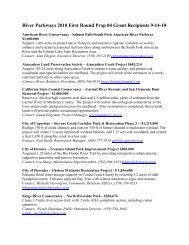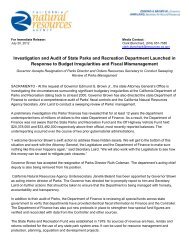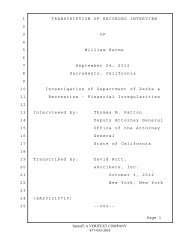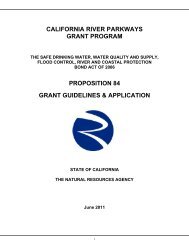California's Ocean Economy - California Resources Agency - State ...
California's Ocean Economy - California Resources Agency - State ...
California's Ocean Economy - California Resources Agency - State ...
You also want an ePaper? Increase the reach of your titles
YUMPU automatically turns print PDFs into web optimized ePapers that Google loves.
NOEP<br />
The travel economy is generally defined as activity associated with travel away from home.<br />
Travel may be undertaken for many purposes, including business, visiting friends and<br />
relatives, and for recreation. Trips may be single or multi-purpose. Travel to coastal<br />
counties in <strong>California</strong> may include coastal recreation or use of a coastal facility in whole or<br />
part. To get a sense of the entire travel industry affecting coastal <strong>California</strong>, we examined<br />
travel and tourism in the state as a whole and in the coastal counties. A portion of the<br />
economic value reported under travel and tourism is ocean related, but we do not know<br />
what that portion is precisely.<br />
Regional Estimates of Economic Impact of <strong>California</strong> Tourism and Recreation<br />
The NOEP team separated employment, wages, and contribution to GSP for those<br />
establishments located in shore-adjacent zip codes and defined this as ocean-related tourism<br />
and recreation. This is a smaller proportion of total travel activity in coastal counties, but it<br />
includes those activities most likely to be affected by ocean and coastal resources. It also<br />
includes the activities of both those who travel or spend money for recreation and for other<br />
purposes such as business.<br />
The next sections of this chapter present data for each of these aspects of Tourism &<br />
Recreation in coastal <strong>California</strong>.<br />
8.2 Coastal Recreational Activities<br />
All economic activities relating to coastal recreation are affected by the quality of the<br />
environment. Coastal land, beaches, watersheds, and coastal waters each provide a link<br />
between the travel and tourism industry and coastal recreational industries such as<br />
swimming, surfing, boating and fishing. The level of participation in coastal water/naturerelated<br />
industries affects several other industries and sectors of the economy. Increased<br />
demand for coastal recreation will result in increased demand for the hotel, restaurant, and<br />
service industry. This will also, indirectly, increase the construction activity along the coast<br />
as more hotels and vacation homes are built. For example, an increase in water-skiing will<br />
increase the manufacture and sale of boats used for these activities. Similarly, an<br />
improvement in a beach will lead to more beach visitors leading to increased beach-wear<br />
demand, which will lead to increased manufacturing and retailing business. Increased<br />
demand will also affect infrastructure construction activities. Roads, parking lots, water and<br />
waste water systems and the like will also be necessary. Therefore, it is important to define<br />
and measure the scale and scope of coastal recreational activities along the <strong>California</strong> coast<br />
before estimating market or non-market values for coastal tourism.<br />
The National Survey of Recreation and Environment (NSRE) in 2000 was the first national<br />
survey that included an assessment of public participation in marine recreation. This survey<br />
defined nineteen activities as part of marine recreation. These nineteen activities can be<br />
divided into four major subgroups: beach activities, recreational fishing, recreational boating,<br />
and other marine recreational activities. Table 8-4 provides the estimates for <strong>California</strong> 48 for<br />
each of these subgroups. Figure 8-2 depicts the proportion of different marine recreational<br />
activities. The NRSE estimation method captures the number of <strong>California</strong> residents who<br />
48 Source NSRE 2000.<br />
106







